
HOME
1/14th Daily Journals for FEBRUARY 1966
1 FEBRUARY 1966 was a continuation of the improvement of the Battalion Base Camp Area, living accommodations as well as defensive perimeter. The Town of Pleiku was put on limits for the men of the 3rd Bde. Passes began at noon and ended at 1700 hours each day. The Town of Pleiku is crowded and offers very little as far a recreation for the men. The troops were also given PX privileges at Camp Holloway located east of Pleiku. The troops were amazed to see the poverty-stricken people who seemed merely to exist rather than live. The town was inhabited by the Vietnamese rather than the Montagnard, who seemed to live in the outlying sections of the area.
2 FEBRUARY 1966 there were no incidents in Base Camp. The day was spent with normal progress under the supervision of Company Fist Sergeants. The normal pass policy was still in effect.
Two platoons from Company A had security mission at Camp Holloway and received sniper fire. There were no casualties.
The Battalion has a practice alert at 1500 hours and everyone went to their bunkers and had a check of all available communication equipment.
Men of Company B went swimming in the Bien Ho Lake and reported it to be very enjoyable.
3 FEBRUARY 1966 the Battalion security elements from each Company returned to Base Camp. The officer in charge made a negative report to the Battalion S2 and was forwarded to the Bde S2. The rest of the day was spent in preparation for the coming operation and improvement of the company areas.
4 FEBRUARY 1966 was spent checking all equipment to ensure that it was operational. All equipment was gathered and put in a central location for loading on the morning of the 5th of February 1966. To insure a successful mission, a Command and Staff meeting was held by the Battalion Commander to discuss plans for the next day. The orders were channeled down the chain of command to the lowest ranking man.
5 FEBRUARY 1966 the 1st Battalion, 14th Infantry departed Base Camp for a marshaling area in the vic of Plei Mrong to participate in the 3rd Bde Task Force operation Taylor. Elements of the Battalion were conveyed by vehicle with the exception of elements of Company C, which were to be helilifted from Base Camp into LZ ACE. Col. Procter was notified by the Bde Commander that the operation was postponed for 24 hours due to the late placement of the supporting artillery. The forward elements prepared their defensive positions for the night to come. Pfc. Barnes of Company A was injured by the accidental detonation of a fragmentation hand grenade. Pfc.Barnes was evacuated by air med-evacuation.
*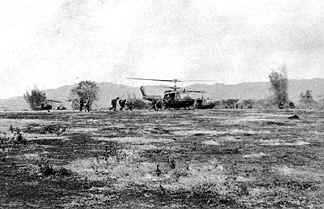 *
*
6 FEBRUARY 1966 this morning the troops has a C Ration breakfast and started their preparation for the helilift into LZ Ace. Captain Cacioppe organized the men of the 1st Battalion, 14th Infantry in serials to be loaded on helicopters and air lifted into the Landing Zone.
*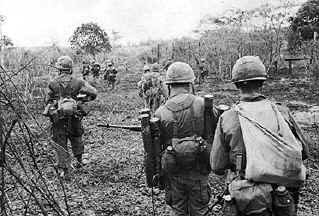 *
*
After all elements had closed into the LZ the Battalion Commander issued a Frag. Order to all Company Commanders. The companies were deployed on line with the mission of search and destroy. The Battalion Commander and S3 moved with the line elements to objective ED and the forward Command Post was established under the supervision of Major Levergood, the Battalion XO. The Battalion trains remained at Plei Mrong and supported the forward elements.
The Recon Platoon and Security Platoon provided security for the forward CP and performed small unit patrols on order from the Battalion XO. There was no enemy contact made by the Battalion today. The battalion consolidated on Objective ED, set up their defense for the night. Water and rations were air lifted to the Battalion with some difficulty in locating a suitable landing zone for the helicopters.
*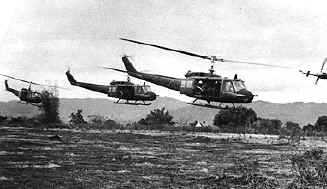 *
*
7 FEBRUARY 1966 the 1st Battalion 14th Infantry moved from objective ED toward objective AL. The undergrowth was very dense and movement was slow. There were several food caches found and destroyed. The tunnels that were found were searched very thoroughly and items found of intelligence matter were sent back to Captain Beal, the Battalion S2.
The movement from objective ED to objective AL found the "Dragons" guiding on a well used trail following the south bank of a rapid flowing creek. The men worked their search and destroy mission with the "Battalion Vee" formation with Company C abreast of Company B and Company A in the rear. With high ground on the left flank of the formation progress was retarded to give the security time to screen the exposed left flank.
*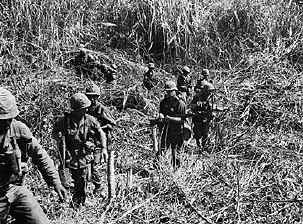 *
*
With the late hours coming on, Col. Procter received an order to locate a landing zone to accommodate four helicopters and secure it for the night. The job was accomplished and the men spent their watch with the night air extremely cold.8 FEBRUARY 1966 the day began with coordinating with the chopper pilots to air lift the units from their location back to the marshaling area to PLEI MRONG. The Command CP with the line companies were air lifted followed by the Forward CP. The 1st Battalion, 14th Infantry was conveyed from PLEI MRONG back to Bases Camp without an incident. The equipment was unloaded and the personal maintenance of the men’s equipment came first. At the end of the day when work was completed the men were transported to the shower.
9 FEBRUARY 1966 it was a busy day for the Battalion. The order was received from Bde that we have the mission of opening and securing an assigned sector of Route 19, located approximately 30 miles east of our Base Camp.
Route 19 was of significant importance to the "GOLDEN DRAGONS" especially at this early date. Most of our resupply came from QUI NHON and Route 19 was, at the time, the only road link between there and the Base Camp.
10 FEBRUARY 1966 the Battalion began preparation for opening Route 19 with a 5:00 AM breakfast. The Recon Platoon, led by LT. L. C. Matthews departed base camp at 0615 hours. The rest of the Battalion and the artillery attachments left at five minute intervals. The trip out Route 19 took about four hours. It was uneventful although Captain Chavis reported receiving sniper fire at one point along the route.
The Battalion was set up in a destroyed town. It was one of the few areas we found large enough to accommodate the CP complex and artillery.
The American Adviser to the 23rd Vietnamese Ranger Battalion, Captain Beasley, came by to coordinate with us, as he was tied in on our left flank. Captain Beasley told us that we were occupying the site of a former District headquarters, which was overrun by the Viet Cong more than a year ago.
We spent the remainder of the day locating our company combat bases and preparing roadblocks to close the road if necessary.
Our sister unit to the east, the 1st Battalion 35th Infantry had one of their mess trucks shot up as it crossed a bridge two miles east of the Mang Yang Pass.
11 FEBRUARY 1966 shortly after this began, about 0015 hours an unidentified number of Viet Cong threw hand grenades into Company A’s area. The only casualty was a small fragment in one soldier’s upper lip.
The artillery and mortars illuminated the entire area but no enemy troops were seen. In the morning hours, short screening patrols went out to search the area for any signs of the Viet Cong who had paid us a call. However, nothing but a few footprints were found.
The Maintenance Platoon spent a busy morning tuning disabled trucks through our area and repairing them when possible. CWO Smith, our mustached maintenance officer was notified via the command net, that his wife had just presented him with baby girl born in Tripler Hospital.
The day was spent escorting convoys through the area and strengthening our positions.
Company A requested an interpreter and an S5 representative to talk to the villagers of Phu Yen. The villagers wandered through the unit area and Captain Chavis was afraid some of them would be shot accidentally. The villagers were more sullen and unfriendly than most of the people we have seen along Route 19.
At noon each unit sent ten men back to Pleiku to see a USO show. Bobby Rydell and his group entertained the troops for about two hours. The report was that the show was very good.
*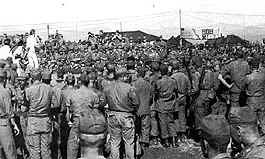 *
*
About 1600 hours the Battalion KO, Major Levergood, and one of the Liaison Officers, Lt. Scott, visited the Command Post of our sister unit, the 1st Battalion 35th Infantry at their location on top of Mang Yang Pass. From the Command Post one could almost see our whole area of responsibility, Quin Nhon to Pleiku.
About 2015 hours Company A received sniper fire from the direction of the village Phu Yen. As flares illuminated the area one Viet Cong was seen dragging a deceased friend away from Company A’s area.
12 FEBRUARY 1966 the morning was spent escorting trucks and patrolling the hills encompassing both sides of the road. A patrol from B Co. led by Lt. Taylor reported finding a clearing with strange markings and camouflaged buildings in it. Further investigation reveals no signs of life or recent habitation.
At 1230 hours A Co. called and reported that a man had been shot in the leg. Our Battalion Surgeon, Capt. Clark flew to A Co. by helicopter to treat the man. This man, SP4 Jackson, had a broken leg and was in shock. We called the "Dustoff" Medevac chopper through Brigade, but it took one hour for it to arrive. As this was our second encounter with delayed medical evacuation, Col. Procter was alarmed. The Brigade Commander, Col. Stoutner, arrived and he was informed of the situation. He said he would look into it, and promised us better evacuation time in the future.
The men received two mail calls today. The S-1 brought a bag of mail out in the afternoon when he came to check on the PDS reports.
A Co. reported sniper fire from the village of Phu Yen three different times during the day.
The remainder of the day was spent escorting convoys and patrolling the high ground in our sector.
13 FEBRUARY 1966 in compliance with the Brigade Commander’s instructions, the Golden Dragons opened it sector of the road at 0700 hours. The morning was spent moving the CP to a new location some 2000 meters east of the abandoned French fort we had occupied for three days.
The Recon Platoon escorted the truck convoys through our area and kept us informed as to their progress.
The Montagnard villagers in the area were moving up and down the road in seemingly aimless pattern. Upon questioning, with the help of our two interpreters, we found the local men were all going to another village to attend a funeral.
A truck passing through our area ran over and killed a Vietnamese child. We felt very badly about it. The child was trying to get candy from the truck driver. We have been giving the children food along the highway since we opened it, and Captain Cacioppe had make the comment previously that the children were getting dangerously bold along the road. At 1635 hours, Lt. Scott took the Battalion Surgeon, Captain Clark, to the site of the wreckage to declare the child dead. As a token of our sympathy, coordination was make with Brigade D5 to deliver several bags of rice, meal candy and medical supplies to the village. This was done on the following day.
Captain Armstrong, Company C Commander reported that one of his NCO’s had apparently gone berserk and requested that the Battalion Headquarters send someone to pick him up. Major Levergood suggested that the NCO be kept in the company area until morning. We learned later that the man had not gone berserk, but had indulged too heavily in some of the local rice wine.
14 FEBRUARY 1966 the unit opened the assigned sector of the road at 0700 hours as was done for the past four days. The first convoy passed through our area at about 0830 hours. The troops were happy to see a truck loaded with beer in the convoy.
About noon the ARVN units near our CP fired a few shots that sent everyone scurrying for cover preparing for an unusual fight. The ARVN couldn’t explain what they were doing.
Major Levergood, the Battalion Executive Officer, went to the village with Brigade S5 to deliver some foodstuffs to the village chief.
A jeep from the Security Platoon was wrecked about 1600 hours by the driver as he was patrolling the road. The night was quiet and negative contact was reported throughout the unit.
15 FEBRUARY 1966 the day began uneventfully with the opening of the road and the usual morning convoys. The men all held hopes of returning to Base Camp by nightfall. At ten o’clock, a Liaison Officer left for Brigade to pick up the order for movement to Base Camp.
No one particularly elected by the Brigade Order, which relieved us at 1200 hours on the 16th. The GOLDEN DRAGONS has a feeling of misuse. We all felt we should be doing something a little more active than guarding trucks.
The remainder of the day was spent coordinating with the 2nd Battalion, 35th Infantry for relieving us on the 16th.
16 FEBRUARY 1966 the morning of 16 February was spent exchanging information and positions with the 2nd Battalion, 35th Infantry. At 1045 hours the Lead Company departed for Base Camp with the other units following.
The remainder of the days was spent cleaning equipment, taking showers, and moving back into our living quarters. During the six days in the field, the rear elements had constructed twenty tent kits. This was a welcome change from "ground living".
The officers had a cook-out in front of Major Levergood’s tent at 1730 hours. A fee of $3.00 each was paid to the S1 who was able to scrounge enough steaks from the Air Force Club at NACV Compound. The Brigade Commander, Col. Stoutner and his Executive Officer, Lt. Col. Feir, came down as our guests to pay their respects and enjoy the hospitality of the "Dragon Clan". Certain officer assignment changes were announced. Captain Robert E. Silvola moved from Headquarters Commandant to Battalion S4, Captain Joseph P. Pellegrino, former S1 assumes duties as CO of Headquarters Company. Captain Harold D. Baughman moved from Motor Officer to S1. Captain George A. Puckhaber moved from S4 to Motor Officer. It was also announced that Lt. James T. Scott would assume duties of Executive Officer, Company B after the next operation.
Two new officers were welcomed into the Battalion by Lt. Col. Procter; 2nd Lt. Robert E. Smith was assigned to Company B and 2nd Lt. Mell R. Godbee was assigned to Company A.
17 FEBRUARY 1966 no reveille of physical training was held this morning since the Road Operation had ended yesterday. The day was spent straightening the Battalion area and catching up on paperwork by the staff.
A lot of "goodies" and luxury items that we had previously done without arrived while we held the road open. The consensus among the troops was that – "In another month or two this place might be all right".
The first issue of jungle boots was handed out to the troops. The boots were limited in quantity and the size range was poor, but the men were glad to get them. Provisions were made for issuing M-16 rifles tomorrow.
Captain Garry Brux, a former "Golden Dragon" and B Company Commander visited the Battalion. Captain Brux is now an advisor to the 3rd Battalion, 1st Airborne Brigade (ARVN) in Saigon. (KIA in October. RIP)
18 FEBRUARY 1966 the eighteenth was spent in familiarizing the men with the M-16 rifle and in zeroing the new weapon. The company mess halls served two "A" ration meals today which were a welcome change from "B" rations.
The engineer water point broke down and water was becoming a critical item of supply. The talcum-like-dust was beginning to smog many of our personnel, especially the mess sergeants. With a critical water supply, most of the troops seldom had clean clothes.
19 FEBRUARY 1966 today was a quiet day in garrison. The companies spent the majority of the day on the range in familiarization and zeroing of the M-16.
Major Levergood and Major Evrard flew with the FAC to look over possible operational areas in the Corps Zone.
The continuing pressure on Special Forces Camps in the Corps Zone by NVA units is the major subject in the staff areas.
20 FEBRUARY 1966 elements of the ground surveillance platoon were attached to the Engineer Company for night observations in the area of the Engineer water point. The security element for the water point reported probing two nights previously.
The 1st Cav. Base at AN KHE was mortared last night and we expect to be mortared in the near future.
Church services, Catholic and Protestant, were held this morning in all Company areas.
The men spent the day on the firing range. Most of the troops were extremely pleased with their new weapons. After Operation "Taylor" and the road mission, the men started to feel the weight of the M-14, and they thought that this "black Matell" was the most!
21 FEBRUARY 1966—23 FEBRUARY 1966 during these three days the men spent their time on passes to Pleiku. Individual equipment maintenance was stressed. Each company continued to improve their company areas.
24 FEBRUARY 1966 today was spent in preparation for Operation "Garfield". Individual equipment was made ready.
25 FEBRUARY 1966 the initial phase of operation "Garfield" was the movement of the entire battalion to New Pleiku Airstrip. Here the men were moved, bag and baggage, to Ban Me Thuot airstrip (east) by C-130s, under the efficient and able guidance of Captain Robert Silvola and his crew. The airstrip was then secured for further incoming equipment. Under this set up, the troop movement was very smooth with little if any difficulty. The entire movement (personnel and light equipment) took approximately 7 ˝ hours which speaks highly for the planning and personnel supervision of all concerned. Luck was also on our side.
26 FEBRUARY 1966 the C-130s poured in their loads of heavy equipment and enough medical supplies to provide for the Golden Dragons and the Cacti as well. A nonpurified supply of water was brought into the area and many of the troops were overcome with diarrhea. This mishap was rectified and the troops were back on their feet in 2 days ready to rejoin their companies. A large supply of toilet paper was then requisitioned.
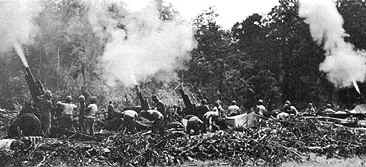
27 FEBRUARY 1966 good weather once again prevailed. A Company left the confines of the airstrip and moved to LZ "Mickey" to secure the 2/9 artillery’s position. The move took place in the early hours of the day and A Company closed in with no difficulty. Companies B and C were still involved with securing the airstrip. Along with this security mission, short range screening patrols were sent out to check infiltration. Both company commanders were planning their initial movement from the airstrip on a probable anticipated search and destroy operation.
28 FEBRUARY 1966 the operation order (3-66) was handed down to all concerned. The mild tension that had arisen the past 3 days was finally broken and the troops were readied. The entire day was one of final preparation and rest.
*[]* Indicates Photo was received from Alan Quale's 3rd Brigade Task Force (66-67) Yearbook
